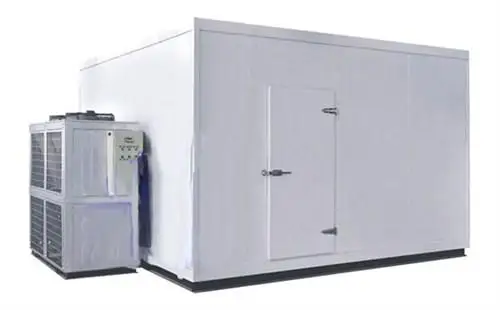Matching Cold Room Doors to Temperature and Insulation Requirements
How temperature requirements impact cold room door performance
Getting cold room doors right for the specific temperature needs of a facility is really important if we want to save on energy bills and keep equipment running smoothly. Take doors made for around -10 degrees Celsius storage areas they just don't have enough insulation to handle those super cold conditions like what's needed at minus 40 degrees. The folks at the Refrigeration Institute did some research back in 2023 and discovered something pretty significant when doors aren't properly matched to temperature requirements. Their findings showed that these mismatches can actually drive up energy expenses by nearly a quarter because compressors end up working way harder than necessary to compensate for heat loss through poorly insulated doors.
Selecting insulation with optimal R-value for operational efficiency
Insulation R-valueâthe measure of thermal resistanceâdirectly correlates with energy savings. For cold storage at -25°C, doors with R-35+ insulation reduce heat transfer by 40% compared to R-25 models. Leading manufacturers now integrate polyurethane foam cores with vapor barriers, achieving R-values up to 45 while minimizing door thickness.
Case study: Maintaining -25°C in supermarkets with high-R-value Cold Room Doors
A Midwest grocery chain reduced defrost cycles by 65% after replacing aging doors with R-40 insulated models. The upgrade maintained consistent -25°C zones despite high traffic, cutting annual energy expenses by $18,200 per store. Thermal imaging confirmed a 90% reduction in cold leakage around door edges.
Trend: Growing demand for ultra-low temperature Cold Room Doors in pharmaceutical storage
Biotech labs and vaccine storage hubs now require doors capable of sustaining -70°C to -80°C. This has driven a 37% YoY increase in orders for triple-panel vacuum-insulated doors, which combine R-50 performance with airtight locking mechanisms for critical pharmaceutical applications.
Ensuring Sealing Efficiency and Preventing Air Infiltration
The Role of Sealing Performance in Minimizing Energy Loss
Good sealing actually stops anywhere from 15 to 30 percent of energy from leaking out in cold storage areas because it keeps those temperature zones properly separated. Even tiny gaps, like just 1.5 millimeters around the door frames of cold rooms, can start creating these annoying convection currents. What happens then is the HVAC system has to put in about 20% extra effort to make up for all that lost cooling power according to research published by ASHRAE back in 2022. For anyone looking at improving their cold storage efficiency, going with continuous gasket seals instead of those segmented ones makes a lot of sense. The segmented versions tend to have those little weak spots where both moisture and cold air can sneak through over time.
Compression Seals vs. Magnetic Gaskets: Performance in Walk-In Freezers
| Feature | Compression Seals | Magnetic Gaskets |
|---|---|---|
| Temperature Range | -40°C to +10°C | -60°C to +25°C |
| Lifespan | 3â5 years (high wear at hinges) | 8â12 years (no mechanical wear) |
| Sealing Efficiency | 85â90% under ideal conditions | 98â99% across all conditions |
| Best For | Low-traffic storage | Pharmaceutical/food processing |
Magnetic gaskets outperform compression models in ultra-low temperatures by maintaining consistent contact despite door frame warping.
Strategies to Prevent Convection Loops and Air Leakage Through Advanced Sealing
Blast freezers equipped with multi layer brush seals see a significant drop in air exchange rates around 37% lower than what we get from those old single gasket designs. The floor area is another big concern for cold storage facilities. Heated door thresholds stop ice from forming right where doors meet the floor, which is actually one of the main spots where energy leaks out accounting for about 12% of all wasted power according to IAQ research from last year. When facilities install automated door closers along with those pressure neutralizing air curtains, they really cut down on unwanted air getting in, especially important in places where doors open and close constantly throughout the day.
Evaluating Durability, Materials, and Environmental Resistance
Cold Room Door materials: Stainless steel, fiberglass, and polymer trade-offs
When it comes to resisting corrosion, stainless steel is hard to beat, which makes it a top choice for cold storage areas that need regular cleaning. The downside? Those heavy doors can make installation a bit of a headache. Fiberglass insulates really well because it doesn't conduct heat much, but if these doors are going outside, they need special coatings to protect against UV damage from sunlight. Polymer doors made with reinforced polyurethane are lighter on the hands during operation and won't rust at all, although they don't hold up as well when something hits them hard compared to steel. According to a recent durability study from 2024, stainless steel doors still kept about 92% of their original strength after sitting in moist conditions for a decade. That's pretty impressive when looking at how most materials degrade over time. Uncoated fiberglass only managed around 78%, showing why proper protection matters so much for long term performance.
Corrosion resistance and structural integrity in high-moisture environments

Stainless steel door frames that are seamless stop water from getting into the joints, which matters a lot in seafood processing plants since salt air really speeds up rusting. Most industry manuals actually stress the importance of checking how different metals react to chlorine cleaners because some alloys just fall apart three times quicker than others when exposed. The electropolishing process creates surfaces that bacteria have trouble sticking to, yet still hold up over time. This becomes especially important for places storing medications that need to meet FDA standards, where even tiny amounts of contamination could be problematic.
Balancing lightweight design and long-term durability in food processing facilities
Aluminum polymer hybrid doors actually weigh about 40 percent less than traditional steel models but still hold up under heavy loads thanks to those internal rib structures for reinforcement. The lighter construction means these doors put less strain on hinges, something that matters a lot in busy commercial kitchens or warehouses where doors might swing open and shut over 100 times each day. Independent tests have confirmed what manufacturers claim: these composite doors can handle around 200 thousand complete openings and closings before showing any real signs of wear. What's really impressive is how little the seals deform during all that action less than half a millimeter at most. That kind of durability makes them ideal for food processing environments like bakeries and dairy facilities where temperatures fluctuate wildly throughout the day, sometimes changing by more than thirty degrees Celsius between morning and night shifts.
Optimizing Energy Efficiency Through Smart Door Design and Operation
Reducing operational costs with energy-efficient Cold Room Doors
According to recent industry standards from ASHRAE, switching to energy efficient cold room doors can cut down on cooling expenses anywhere between 24% to maybe even 30% in those big industrial refrigeration setups. The newer door designs typically feature around 80mm thick polyurethane insulation along with three separate sealing points around the edges. These improvements help stop something called thermal bridging, which is actually responsible for roughly a third or so of all wasted energy in older door models. Take one grocery store chain that did a complete overhaul in 2022 as an example. They replaced about 134 of their old freezer doors with ones certified by Energy Star and saw their heating and cooling bills drop by approximately 18%. Pretty impressive savings when you consider how much these facilities run their refrigeration systems day in and day out.
Innovation: Vacuum insulation panels in modern Cold Room Door systems
Vacuum insulation panels (VIPs) now achieve R-values of 45â50/inchâ700% more efficient than traditional PIR foam. These 25mm-thick panels enable slimmer door profiles while maintaining -30°C environments, as validated by USDA cold chain trials. Pharmaceutical warehouses using VIP-equipped doors report 22% faster temperature stabilization post-entry.
Addressing energy loss from frequent door cycling in distribution centers
Distribution centers lose 300â500 kWh daily through door air exchange (DOE 2023 Energy Chartbook). High-traffic facilities averaging 75+ door openings/hour can mitigate losses using:
| Strategy | Energy Savings | Implementation Cost |
|---|---|---|
| Air curtain augmentation | 12â18% | $2,800/door |
| Infrared traffic sensors | 9â15% | $1,200/door |
| Scheduled access windows | 21â27% | Operational change |
Solution: Rapid-cycle and sensor-activated doors for high-throughput facilities
Modern high-speed cold room doors operate at 1.2â1.8 second cycles using brushless DC motors, reducing open-state duration by 68% compared to standard models. A Midwest frozen food distributor achieved 31% annual energy savings after installing radar-activated doors that only trigger for full pallet movements, eliminating 43% of unnecessary activations.
Managing Frost, Condensation, and Hygiene for Long-Term Performance
Preventing Frost Build-Up With Effective Defrost Systems and Thresholds
Automatic defrost cycles in cold room doors prevent ice accumulation on seals and hingesâcritical for maintaining consistent closure in sub-zero environments. Heated thresholds eliminate ground-level frost formation, with operators reporting 40% fewer manual defrost interventions compared to standard models.
Controlling Condensation Through Strategic Door Placement and Design
Proper cold room door positioning minimizes temperature differentials that cause moisture buildup. Sloping threshold designs redirect condensation away from doorways, while dual-panel glass viewing windows with thermal breaks reduce internal fogging. Recent studies show facilities using these techniques achieve 22% lower humidity variance during peak operations.
Case Study: Dairy Facility Improves Uptime With Heated Threshold Cold Room Doors
A Midwest dairy processor reduced freezer downtime by 18 hours/month after installing doors with integrated heated thresholds. The $15k upgrade paid back in 8 months through reduced defrost cycles and prevented product loss from door seal failures.
Meeting Hygiene Standards in Food and Pharmaceutical Cold Room Door Designs
Seamless stainless steel surfaces and antimicrobial handle coatings now meet FDA/EU GMP requirements for cleanroom-adjacent storage. Doors with rounded corners and integrated drainage channels enable 70% faster washdown cycles in meat processing facilities compared to traditional designs.
Frequently Asked Questions
What is the significance of insulation R-value in cold room doors?
The insulation R-value measures thermal resistance. Higher R-values, such as R-35 or greater, significantly reduce heat transfer and are crucial for energy savings in cold storage, especially at very low temperatures like -25°C.
Why are magnetic gaskets preferred over compression seals for cold room doors?
Magnetic gaskets maintain better sealing efficiency across varying temperatures and conditions, providing longer lifespans and reducing air leakage compared to compression seals.
How do vacuum insulation panels enhance cold room door efficiency?
Vacuum insulation panels provide higher R-values, enabling slimmer door designs while maintaining low-temperature environments, significantly improving energy efficiency in cold room door systems.
What advancements are being made in cold room door designs to reduce energy consumption?
Recent innovations include high-speed doors with brushless DC motors, infrared sensors, and vacuum insulation panels, all of which contribute to reducing operational costs by minimizing energy loss and door cycling time.
How can sealing efficiency impact the energy consumption of a cold room?
Proper sealing prevents energy loss by minimizing air infiltration and convection currents, which in turn reduces the load on HVAC systems and improves overall energy efficiency.
Table of Contents
-
Matching Cold Room Doors to Temperature and Insulation Requirements
- How temperature requirements impact cold room door performance
- Selecting insulation with optimal R-value for operational efficiency
- Case study: Maintaining -25°C in supermarkets with high-R-value Cold Room Doors
- Trend: Growing demand for ultra-low temperature Cold Room Doors in pharmaceutical storage
- Ensuring Sealing Efficiency and Preventing Air Infiltration
- Evaluating Durability, Materials, and Environmental Resistance
- Optimizing Energy Efficiency Through Smart Door Design and Operation
- Managing Frost, Condensation, and Hygiene for Long-Term Performance
-
Frequently Asked Questions
- What is the significance of insulation R-value in cold room doors?
- Why are magnetic gaskets preferred over compression seals for cold room doors?
- How do vacuum insulation panels enhance cold room door efficiency?
- What advancements are being made in cold room door designs to reduce energy consumption?
- How can sealing efficiency impact the energy consumption of a cold room?

